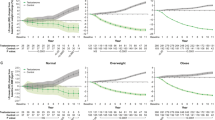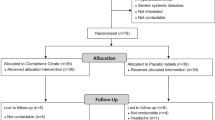Abstract
Aim: To investigate efficacy and safety of two different preparations of testosterone undecanoate (TU) in 52 hypogonadal men [mean age 57 yr and mean testosterone (T) < 320 ng/dl] with metabolic syndrome (MS). Subjects and methods: Randomized, double-blind, double-dummy study with three parallel treatment arms [oral TU; transdermal placebo gel (P); im TU] administration for 12 months (mo). Each subject was randomized (1:1:3) to receive either oral TU (2 capsules of 40 mg/twice per day at breakfast and dinner, equalling a total dose of 160 mg/day; no.=10) for 6 mo and continued with im TU for further 6 mo, or P (3–4 g/day; no.=10) and im TU (1000 mg/12 weeks from week 6; no.=32) for 12 mo. Results: After 6 mo, im TU increased T and free-T levels (p<0.0001), and improved metabolic parameters [reduction in Homeostasis Model Assessment (HOMA) index, p<0.0001; waist circumference and fat mass, p<0.001, respectively], in International Index of Erectile Function-5 and Aging Males’ Symptoms scores (p<0.01, respectively). After 12 months, im TU produced further increases in T and free-T levels (p<0.0001) and metabolic parameters (reduction in HOMA-index, p<0.0001; waist circumference p<0.0001; fat mass, p<0.001). No major adverse event due to T treatment occurred. Conclusions: Clinical efficacy of T replacement therapy in hypogonadal men with MS is reached when its plasmatic levels approach into the medium-high range of normality (>5 ng/ml), although subjective threshold values may be different. Administration of im TU was more effective than oral TU to reach the target for T levels and to improve MS parameters. TU was safe over 12 months and discontinuation rates were similar to placebo.
Similar content being viewed by others
References
Traish AM, Guay A, Feeley R, Saad F. The dark side of testosterone deficiency: I. Metabolic syndrome and erectile dysfunction. J Androl 2009, 30: 10–22.
Traish AM, Saad F, Guay A. The dark side of testosterone deficiency: II. Type 2 diabetes and insulin resistance. J Androl 2009, 30: 23–32.
Fukui M, Kitagawa Y, Ose H, Hasegawa G, Yoshikawa T, Nakamura N. Role of endogenous androgen against insulin resistance and atherosclerosis in men with type 2 diabetes. Curr Diab Rev 2007, 3: 25–31.
Traish AM, Saad F, Feeley RJ, Guay AT. The dark side of testosterone deficiency: III. Cardiovascular disease. J Androl 2009, 30: 477–94.
Malkin CJ, Pugh PJ, West JN, van Beek EJ, Jones TH, Channer KS. Testosterone therapy in men with moderate severity heart failure: a double-blind randomized placebo controlled trial. Eur Heart J 2006, 27: 57–64.
Feldman HA, Longcope C, Derby CA, et al. Age trends in the level of serum testosterone and other hormones in middle-aged men: longitudinal results from the Massachusetts Male Aging Study. J Clin Endocrinol Metab 2002, 87: 589–8.
Harman SM, Metter EJ, Tobin JD, Pearson J, Blackman MR. Longitudinal effects of aging on serum total and free testosterone levels in healthy men. Baltimore Longitudinal Study of Aging. J Clin Endocrinol Metab 2001, 86: 724–31.
Bhasin S, Buckwalter JG. Testosterone supplementation in older men: a rational idea whose time has not yet come. J Androl 2001, 22: 718–31.
Kshirsagar A, Seftel A, Ross L, Mohamed M, Niederberger C. Predicting hypogonadism in men based upon age, presence of erectile dysfunction, and depression. Int J Impot Res 2006, 18: 47–51.
Smith MR, Lee H, Nathan DM. Insulin sensitivity during combined androgen blockade for prostate cancer. J Clin Endocrinol Metab 2006, 91: 1305–8.
Basaria S, Muller DC, Carducci MA, Egan J, Dobs AS. Hyperglycemia and insulin resistance in men with prostate carcinoma who receive androgen-deprivation therapy. Cancer 2006, 106: 581–8.
National Cholesterol Education Program (NCEP) Expert Panel on Detection, Evaluation, and Treatment of High Blood Cholesterol in Adults (Adult Treatment Panel III). Adult Treatment Panel III. Third report of the National Cholesterol Education Program (NCEP) Expert Panel on Detection, Evaluation, and Treatment of High Blood Cholesterol in Adults. Circulation 2002, 106: 3143–421.
Alberti KG, Zimmet P, Shaw J. The metabolic syndrome — a new worldwide definition. Lancet 2005, 366: 1059–62.
Rodriguez A, Muller DC, Metter EJ, et al. Aging, androgens, and the metabolic syndrome in a longitudinal study of aging. J Clin Endocrinol Metab 2007, 92: 3568–72.
Simon D, Charles MA, Nahoul K, et al. Association between plasma total testosterone and cardiovascular risk factors in healthy adult men: The Telecom Study. J Clin Endocrinol Metab 1997, 82: 682–5.
Nieschlag E, Swerdloff R, Behre HM, et al. Investigation, treatment, and monitoring of late-onset hypogonadism in males: ISA, ISSAM, and EAU recommendations. J Androl 2006, 27: 135–7.
Heinemann LAJ, Saad F, Zimmermann T, et al. The Aging Males’ Symptoms (AMS) scale: Update and compilation of international versions. Health Qual Life Outcomes 2003, 1: 1–15.
Moore C, Huebler D, Zimmermann T, Heinemann LAJ, Saad F, Thai DM. The Aging Males’ Symptoms scale (AMS) as outcome measure for treatment of androgen deficiency. Eur Urol 2004, 46: 80–7.
Heinemann LAJ, Saad F, Heinemann K, Thai DM. Can results of the Aging Males’ Symptoms (AMS) scale predict those of screening scales for androgen deficiency? Aging Male 2004, 7: 211–8.
Rosen RC, Cappelleri JC, Smith MD, Lipsky J, Peña BM. Development and evaluation of an abridged, 5-item version of the International Index of Erectile Function (IIEF-5) as a diagnostic tool for erectile dysfunction. Int J Impot Res 1999, 11: 319–26.
Prior BM, Cureton KJ, Modlesky CM, et al. In-vivo validation of whole body composition estimates from dual-energy X-ray absorptiometry. J Appl Physiol 1997, 83: 623–30.
Bolanowski M, Nilsson BE. Assessment of human body composition using dual-energy x-ray absorptiometry and bioelectrical impedance analysis. Med Sci Monit 2001, 7: 1029–33.
Shinohara K. Transrectal ultrasonography in the evaluation of benign prostatic hyperplasia. In: Benign prostatic hyperplasia. Florida, USA: Churchill Livingston. 2000, 125–37.
Chenven ES, Glazier DB, Krisch EB et al. Evaluation of prostate volume by transrectal ultrasonography for use in a brachy therapy program. Urology 2001, 58: 752–5.
Boyanov MA, Boneva Z, Christov VG. Testosterone supplementation in men with type 2 diabetes, visceral obesity and partial androgen deficiency. Aging Male 2003, 6: 1–7.
Haren M, Chapman I, Coates P, Morley J, Wittert G. Effect of 12 month oral testosterone on testosterone deficiency symptoms in symptomatic elderly males with low-normal gonadal status. Age Ageing 2005, 34: 125–30.
Kapoor D, Goodwin E, Channer KS, et al. Testosterone replacement therapy improves insulin resistance, glycaemic control, visceral adiposity and hypercholesterolaemia in hypogonadal men with type 2 diabetes. Eur J Endocrinol 2006, 154: 899–906.
Pitteloud N, Mootha VK, Dwyer AA, et al. Relationship between testosterone levels, insulin sensitivity, and mitochondrial function in men. Diabetes Care 2005, 28: 1636–42.
Yialamas MA, Dwyer AA, Hanley E, Lee H, Pitteloud N, Hayes FJ. Acute sex steroid withdrawal reduces insulin sensitivity in healthy men with idiopathic hypogonadotropic hypogonadism. J Clin Endocrinol Metab 2007, 92: 4254–9.
Stanworth RD, Jones TH. Testosterone in obesity, metabolic syndrome and type 2 diabetes. Front Horm Res 2009, 37: 74–90.
Saad F, Gooren L. The role of testosterone in the metabolic syndrome: a review. J Steroid Biochem Mol Biol 2009, 114: 40–3.
Kapoor D, Malkin CJ, Channer KS, Jones TH. Androgens, insulin resistance and vascular disease in men. Clin Endocrinol (Oxf) 2005, 63: 239–50.
Haffner SM. The metabolic syndrome: inflammation, diabetes mellitus, and cardiovascular disease. Am J Cardiol 2006, 97: 3A-11A.
Aronne LJ. Classification of obesity and assessment of obesity related health risks. Obes Res 2002 10: 105S-15S.
Kapoor D, Clarke S, Stanworth R, Channer KS, Jones TH. The effect of testosterone replacement therapy on adipocytokines and C-reactive protein in hypogonadal men with type 2 diabetes. Eur J Endocrinol 2007, 156: 595–602.
Corona G, Mannucci E, Forti G, Maggi M. Hypogonadism, ED, metabolic syndrome and obesity: a pathological link supporting cardiovascular diseases. Int J Androl 2009, 32: 587–98.
Stanik S, Dornfeld LP, Maxwell MH, Viosca SP, Korenman SG. The effect of weight loss on reproductive hormones in obese men. J Clin Endocrinol Metab 1981, 53: 828–32.
Niskanen L, Laaksonen DE, Punnonen K, Mustajoki P, Kaukua J, Rissanen A. Changes in sex hormone-binding globulin and testosterone during weight loss and weight maintenance in abdominally obese men with the metabolic syndrome. Diabetes Obes Metab 2004, 6: 208–15.
Strain G, Zumoff B, Rosner W, Pi-Sunyer X. The relationship between serum levels of insulin and sex hormone-binding globulin in men: the effect of weight loss. J Clin Endocrinol Metab 1994, 79: 1173–6.
Niskanen L, Laaksonen DE, Punnonen K, Mustajoki P, Kaukua J, Rissanen A. Changes in sex hormone-binding globulin and testosterone during weight loss and weight maintenance in abdominally obese men with the metabolic syndrome. Diabetes Obes Metab 2004, 6: 208–15.
Vermeulen A, Kaufman JM, Giagulli VA. Influence of some biological indexes on sex hormone-binding globulin and androgen levels in aging or obese males. J Clin Endocrinol Metab 1996, 81: 1821–6.
Corona G, Mannucci E, Petrone L, et al. NCEP-ATPIII-defined metabolic syndrome, type 2 diabetes mellitus, and prevalence of hypogonadism in male patients with sexual dysfunction. J Sex Med 2007, 4: 1038–45.
Corona G, Monami M, Boddi V, et al. Low testosterone is associated with an increased risk of MACE lethality in subjects with erectile dysfunction. J Sex Med 2010, 7: 1557–64.
Isidori AM, Giannetta E, Greco EA, et al. Effects of testosterone on body composition, bone metabolism and serum lipid profile in middle-aged men: a meta-analysis. Clin Endocrinol (Oxf) 2005, 63: 280–93.
Author information
Authors and Affiliations
Corresponding author
Rights and permissions
About this article
Cite this article
Aversa, A., Bruzziches, R., Francomano, D. et al. Efficacy and safety of two different testosterone undecanoate formulations in hypogonadal men with metabolic syndrome. J Endocrinol Invest 33, 776–783 (2010). https://doi.org/10.1007/BF03350341
Published:
Issue Date:
DOI: https://doi.org/10.1007/BF03350341




